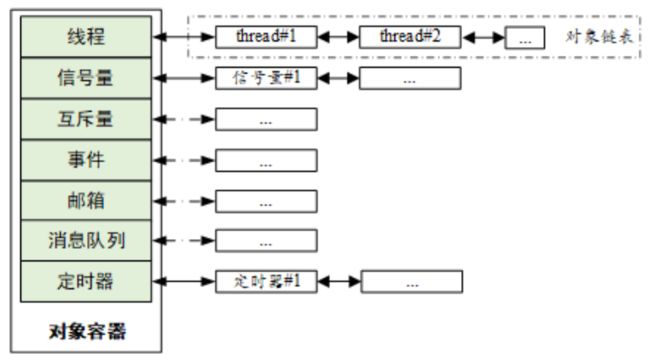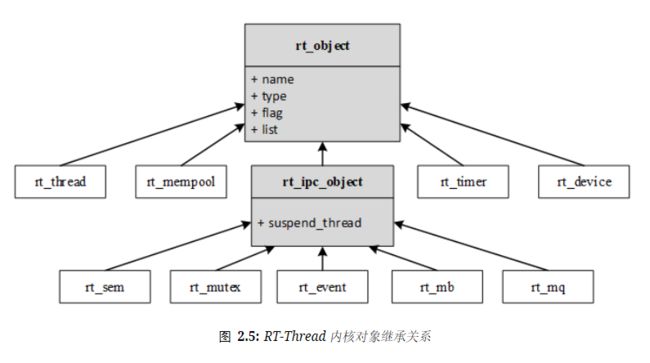RT-Thread对象管理解析(通过线程创建源码分析)
layout: post
title: “对象管理”
date: 2024-1-30 15:39:08 +0800
tags: RT-Thread
对象管理
RT-Thread的对象可以使用动态创建以及静态创建, 使用动态的话需要定义一个宏定义RT_USING_HEAP, 有这一个宏定义后会使用堆区进行初始化
一般使用动态的函数为rt_xxx_create(), 静态的为rt_xxx_init()
内核对象的管理
RT-Thread采用内核对象管理系统来访问/管理所有内核对象,内核对象包含了内核中绝大部分设施
这些对象可以是静态的也可以是动态创建的
- 使用链表的方式进行管理
- 使用继承的方式进行管理
可以使用统一的接口对对象进行管理
主要使用的类型
//一个基础类型, 一般位于内核对象的最前方, 用于记录一个对象的信息 struct rt_object { /*内核对象名称*/ char name[RT_NAME_MAX]; /*内核对象类型*/ rt_uint8_t type; /*内核对象的参数*/ rt_uint8_t flag; /*内核对象管理链表*/ rt_list_t list; };/**可以使用的对象类型 * The object type can be one of the follows with specific * macros enabled: * - Thread * - Semaphore * - Mutex * - Event * - MailBox * - MessageQueue * - MemHeap * - MemPool * - Device * - Timer * - Unknown * - Static */ enum rt_object_class_type { RT_Object_Class_Null = 0x00, /**< The object is not used. */ RT_Object_Class_Thread = 0x01, /**< 对象为线程类型 */ RT_Object_Class_Semaphore = 0x02, /**< 对象为信号量类型 */ RT_Object_Class_Mutex = 0x03, /**< 对象为互斥量类型 */ RT_Object_Class_Event = 0x04, /**< 对象为事件类型 */ RT_Object_Class_MailBox = 0x05, /**< 对象为邮箱类型 */ RT_Object_Class_MessageQueue = 0x06, /**< 对象为消息队列类型 */ RT_Object_Class_MemHeap = 0x07, /**< memory heap. */ RT_Object_Class_MemPool = 0x08, /**< memory pool. */ RT_Object_Class_Device = 0x09, /**< 对象为设备类型 */ RT_Object_Class_Timer = 0x0a, /**< 对象为定时器类型 */ RT_Object_Class_Unknown = 0x0c, /**< 对象类型未知 */ RT_Object_Class_Static = 0x80 /**< 对象为静态对象, 这是一个标志位 */ };/** * The information of the kernel object, 这一个是用于记录初始化信息的临时变量 */ struct rt_object_information { enum rt_object_class_type type; /**< object class type */ rt_list_t object_list; /**< object list */ rt_size_t object_size; /**< object size */ };RT-Thread使用一个结构体数组
static struct rt_object_information rt_object_container[RT_Object_Info_Unknown]保存默认的信息
管理的API
初始化一个静态的对象
/**实际上是对一个以及存在的类型进行赋值以及链表的插入
* This function will initialize an object and add it to object system
* management.
*
* @param object the specified object to be initialized.
* @param type the object type.
* @param name the object name. In system, the object's name must be unique.
*/
void rt_object_init(struct rt_object *object,
enum rt_object_class_type type,
const char *name)
系统会把这个对象放置到对象容器中进行管理,即初始化对象的一些参数,然后把这个对象节点插入到对象容器的对象链表中
脱离一个对象
/**
* This function will detach a static object from object system,
* and the memory of static object is not freed.
*
* @param object the specified object to be detached.
*/
void rt_object_detach(rt_object_t object)
使得一个静态内核对象从内核对象容器中脱离出来,即从内核对象容器链表上删除相应的对象节点。
动态创建以及删除
/**清除类型以及链表的脱离
* This function will allocate an object from object system
*
* @param type the type of object
* @param name the object name. In system, the object's name must be unique.
*
* @return object
*/
rt_object_t rt_object_allocate(enum rt_object_class_type type, const char *name)
/**多了一个释放内存
* This function will delete an object and release object memory.
*
* @param object the specified object to be deleted.
*/
void rt_object_delete(rt_object_t object)
判断一个对象是不是静态对象
/**判断static标志位
* This function will judge the object is system object or not.
* Normally, the system object is a static object and the type
* of object set to RT_Object_Class_Static.
*
* @param object the specified object to be judged.
*
* @return RT_TRUE if a system object, RT_FALSE for others.
*/
rt_bool_t rt_object_is_systemobject(rt_object_t object)
实际的管理示例(动态)
- 以下用线程的初始化为例
/**
* This function will create a thread object and allocate thread object memory
* and stack.
*
* @param name the name of thread, which shall be unique
* @param entry the entry function of thread
* @param parameter the parameter of thread enter function
* @param stack_size the size of thread stack
* @param priority the priority of thread
* @param tick the time slice if there are same priority thread
*
* @return the created thread object
*/
rt_thread_t rt_thread_create(const char *name,
void (*entry)(void *parameter),
void *parameter,
rt_uint32_t stack_size,
rt_uint8_t priority,
rt_uint32_t tick)
{
struct rt_thread *thread;
void *stack_start;
//获取一个线程对象
thread = (struct rt_thread *)rt_object_allocate(RT_Object_Class_Thread,
name);
if (thread == RT_NULL)
return RT_NULL;
//获取一块栈区
stack_start = (void *)RT_KERNEL_MALLOC(stack_size);
if (stack_start == RT_NULL)
{
/* allocate stack failure */
rt_object_delete((rt_object_t)thread);
return RT_NULL;
}
//这个函数主要是用来填充信息的, 以及栈的初始化, 不在这里讨论(详细看线程管理的笔记, 以后会更新)
_rt_thread_init(thread,
name,
entry,
parameter,
stack_start,
stack_size,
priority,
tick);
return thread;
}
/**
* This function will allocate an object from object system
*
* @param type the type of object
* @param name the object name. In system, the object's name must be unique.
*
* @return object
*/
rt_object_t rt_object_allocate(enum rt_object_class_type type, const char *name)
{
struct rt_object *object;
register rt_base_t temp;
struct rt_object_information *information;
RT_DEBUG_NOT_IN_INTERRUPT;
/* get object information 获取想要的对象的信息 */
information = rt_object_get_information(type);
RT_ASSERT(information != RT_NULL);
//根据获取的信息进行分配一块内存, object对象实际上是这一个结构体的前几项
object = (struct rt_object *)RT_KERNEL_MALLOC(information->object_size);
if (object == RT_NULL)
{
/* no memory can be allocated */
return RT_NULL;
}
/* clean memory data of object 把所有的位清零*/
rt_memset(object, 0x0, information->object_size);
/* initialize object's parameters 以下是初始化object的变量 */
/* set object type */
object->type = type;
/* set object flag */
object->flag = 0;
/* copy name */
rt_strncpy(object->name, name, RT_NAME_MAX);
RT_OBJECT_HOOK_CALL(rt_object_attach_hook, (object));
/* lock interrupt */
temp = rt_hw_interrupt_disable();
/* insert object into information object list 插入队列里面 */
rt_list_insert_after(&(information->object_list), &(object->list));
/* unlock interrupt */
rt_hw_interrupt_enable(temp);
/* return object */
return object;
}
/**
* This function will return the specified type of object information.
*
* @param type the type of object, which can be
* RT_Object_Class_Thread/Semaphore/Mutex... etc
*
* @return the object type information or RT_NULL
*/
struct rt_object_information *
rt_object_get_information(enum rt_object_class_type type)
{
int index;
//依次和保存的信息结构体里面的数值比较, 获取对应的类型的信息
for (index = 0; index < RT_Object_Info_Unknown; index ++)
if (rt_object_container[index].type == type) return &rt_object_container[index];
return RT_NULL;
}

